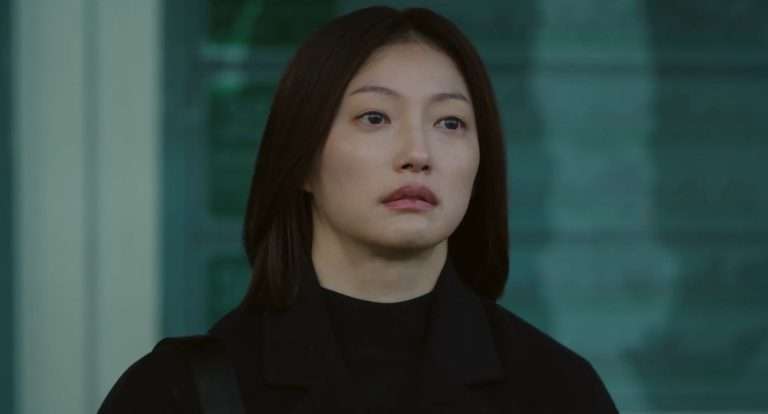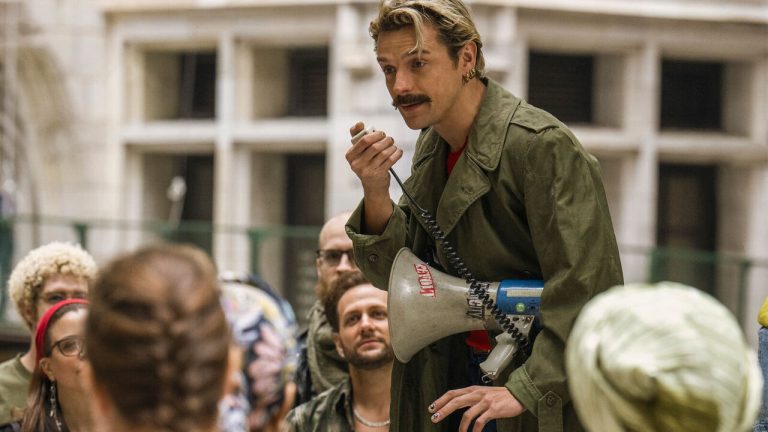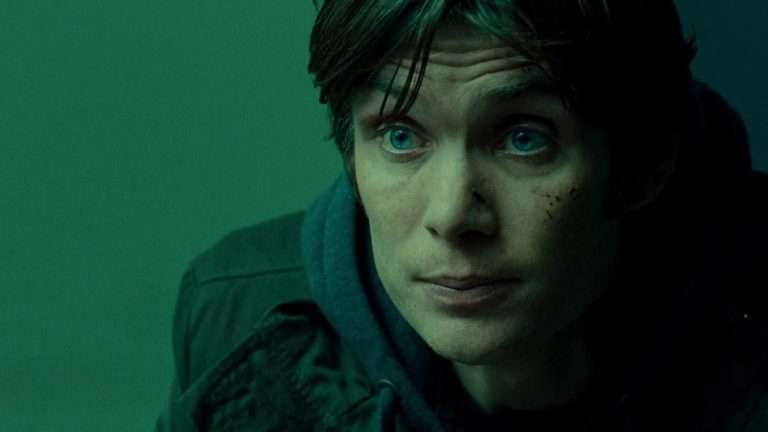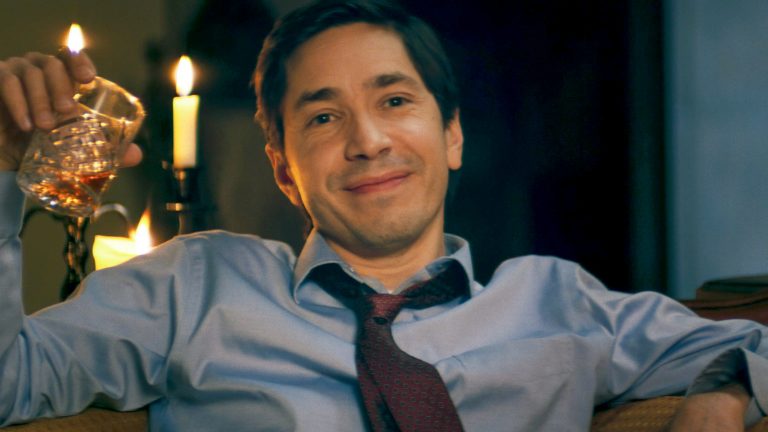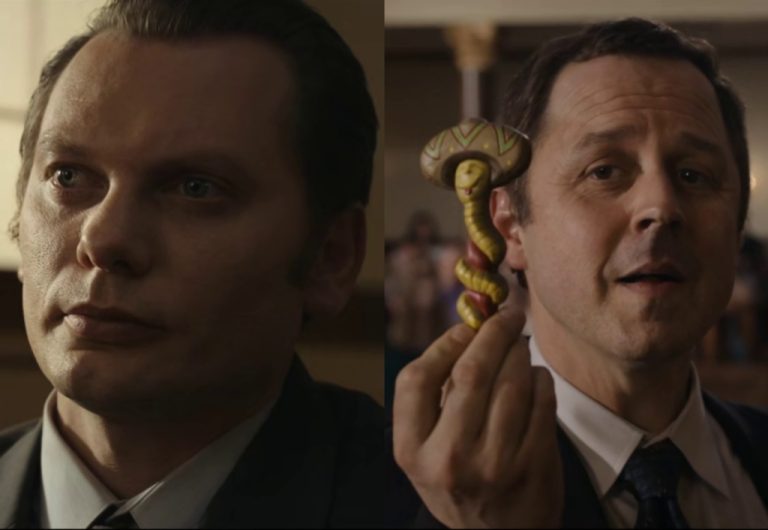“Watchmen – Chapter II” (2024) continues from the first installment, adapting issues 7 to 12 of the original graphic novel written by Alan Moore and illustrated by Dave Gibbons. The animated movie having Dave Gibbons as an executive producer does help it have some amount of fidelity.
Watchmen: Chapter II (2024) Plot Summary & Movie Synopsis:
How does Dan Drieberg get his mojo back?
The seventh chapter of the graphic novel does get major short shrift in this adaptation, with the entire section dealing with Drieberg recounting his origin story as Nite Owl to Laurie while exploring the basement utterly excised, streamlined with choice dialogues utilized later. What remains intact is Drieberg’s admitting that most of these superhero costumes essentially seem like dress-ups for grown individuals to live out their fantasies.
What he doesn’t voice out, but the film and graphic novel essentially overlay, is that Drieberg is unable to get himself excited, even though both he and Laurie essentially act on their mutual attraction for each other. This leads to Dan being ultimately held by Laurie in her arms like a baby and sleeping.
Dan’s dream telegraphs the next few moments of Laurie and Drieberg’s moves. His dream of approaching a naked Laurie, with Laurie then shedding his skin off to reveal the Nite-Owl costume underneath, with Drieberg doing the same is essentially what happens later on. The impotence Drieberg feels stems from not living out the fantasy, from feeling essentially powerless at being unable to investigate the recent occurrences of the impending war.
To counter that, Laurie and Dan dress up in their crime-fighting costumes and take out Dan’s ship, Archie, for a spin. After rescuing several tenants from a burning apartment building, their emotions run high enough that they finally consummate on the ship. Later, when they are coming down from the high of their sexual act, Dan proposes to break Rohrshach out of prison.
Who is Walter Kovacs?
Walter Kovacs is the person with Rohrshach the mask, or is it the other way around? If you ask him, or attempt to, while he busts noses and fights through the goons of “Big Figure,” a dwarfish crime boss who is essentially running the prison and leads the way to dispatch Rohrshach as revenge. After all, Rohrshach’s shrink would resign immediately as well.
Considering Kovacs’ violent origin story and his mostly unrepentant nature, it makes sense for the shrink to find himself as a losing cause and more someone horrified at Rohrshach’s mindset. The son of a sex worker, who would be bullied by his mother as well as the kids around his neighborhood, Rohrshach would grow up to be a hardened individual with an anger-tinged look towards humanity.
While working as a garment worker, he would acquire a certain dress fabric that entails the black and white coloration to co-exist without intermixing. He finds out that the dress had been ordered by one Kitty Genovese. When Genovese would later fail to turn up to take the dress and he reads up on her rape and murder, Kovacs would fashion a mask out of the rejected clothes, angered at the bystander syndrome and fashioning a “face that he could look in the mirror.”.
In 1975, Rohrshach investigated the kidnapping of a six-year-old girl named Blair Roache. He tracked it to the home of one Gerald Grice. What he finds there—a bloody knife, hands and feet being cut off, with the bones fed to the dogs—Kovacs states that “he would close his eyes, and Rohrshach would open that.” If any event leads to Rohrshach attaining a nihilistic attitude toward humanity, many believe it has been this incident. He would kill the dogs with that same meat cleaver, handcuff the returning Grice to his stove, pour kerosene around him, and burn the house down. He would leave Grice a hacksaw on the off chance Grice would try to escape, though he warns that there won’t be any time.
How does Kovacs escape prison?
The events of last night, while cathartic for the couple, raise eyebrows around the city. Drieberg is visited by his mentor, Hollis Mason/Nite Owl I, where Hollis points out that he knows about last night. While Laurie listened to their conversation from the computers in the basement, Drieberg underlined the investigation he had been conducting on Jon’s exile and how the magazine Nova Express and the Institute of Interspatial Research that employed all of Jon’s cancer victims are all owned by the same company. He believes in Rohrshach’s plan of a conspiracy to kill all “masks” and ensure World War III. Hollis encourages him to continue but also warns Dan that if he could figure it out, the police wouldn’t be far behind.
As Laurie and Drieberg dress up as Nite Owl II and Silk Spectre and fly out of the cave, Dreiberg watches in sorrow as his house is raided by the police. Realizing that clearing their names is the only way, they fly out to the prison, which is in the middle of a riot. Meanwhile, Rohrshach is threatened by “Big Figure,” to the extent that he kills one of his henchmen when their hands are tied up to the bars of the cell by Rohrshach. Rohrshach very cleverly dispatches his henchmen without raising his hands, and utilizes his wits and his opponents’ lack of spatial awareness, to kill them. As “Big Figure” runs away in horror, Kovacs calmly follows him, missing an angry Nite Owl and Juspeczyk searching for him.
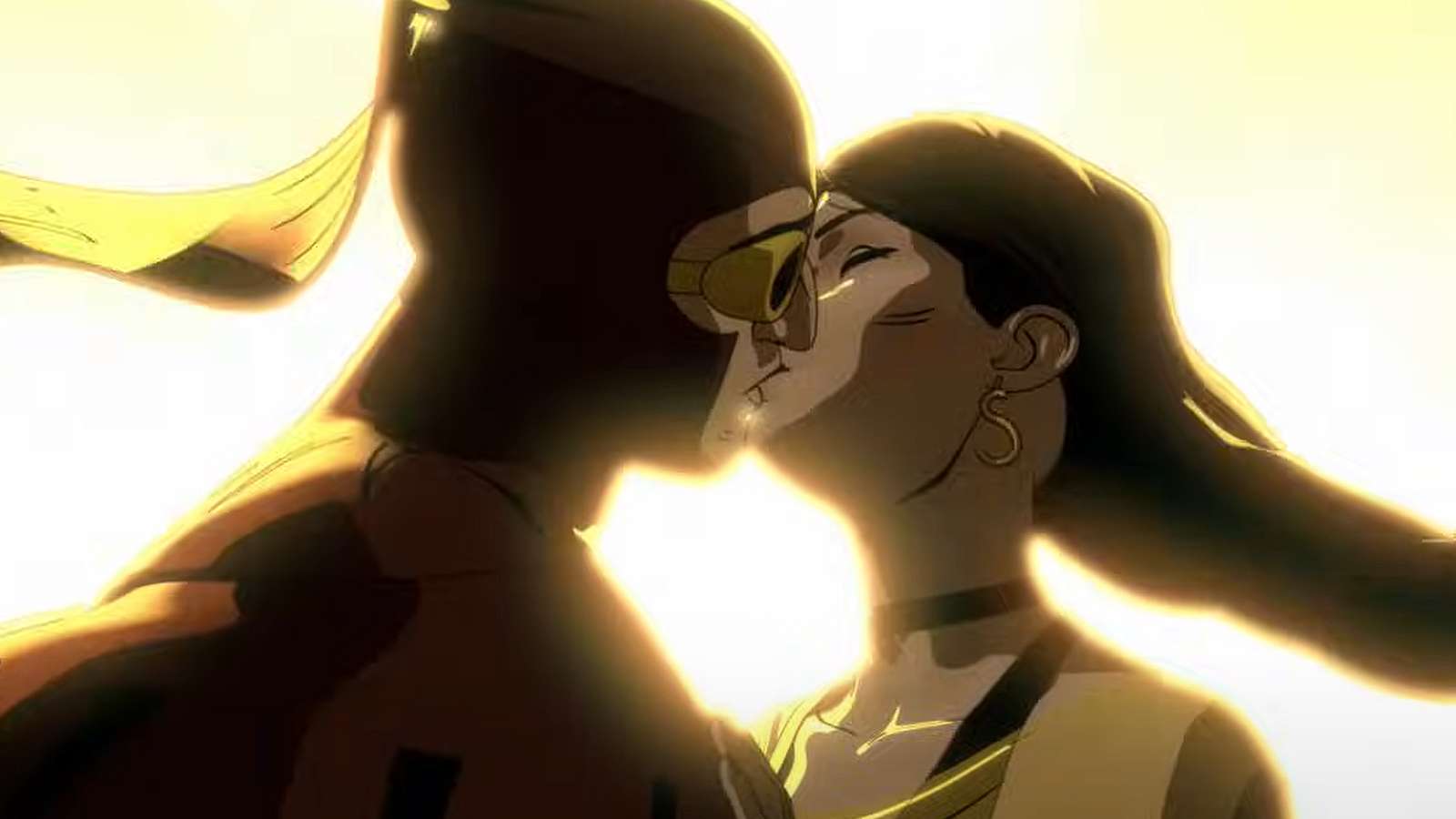
He is heavily implied to have killed “Big Figure” and shoved his head down the toilet bowl before allowing himself to be rescued by Nite Owl and Silk Spectre. Their victory lap would be short-lived, as Doctor Manhattan would appear in Nite-Owl’s ship and take Silk Spectre away to Mars, believing that they have a conversation scheduled where Laurie would try to convince Jon to come back to Earth and save humanity.
How does Laurie convince Jon to come back to Earth?
Laurie, being teleported to Mars, almost dies due to the lack of an atmosphere before being cloaked with a breathable shield. It exacerbates her anger at Jon. But it doesn’t also take away from her being shocked at Jon’s having created a levitating castle on Mars soil. From Jon’s perspective, Laurie finally becoming close with Dan would sever any tether Jon has to humanity, with Jon believing that humanity is overrated and planets can survive quite well without their presence, like Mars with its chaotic terrain. As Laurie tries to convince Jon of her own “chaotic terrain,” she realizes a mix of flashbacks and her previous conversations with her mother—that her father had been Edward Blake/The Comedian, born out of an encounter between the two of them years after her sexual assault at the Minutemen headquarters.
It is heavily implied that Blake wanted to get close to his daughter but would be obstructed by Sally Jupiter. However, the unlikely fact that Blake and Jupiter would get together and result in the creation of Laurie is a “thermodynamic miracle,” according to Doctor Manhattan, which, if he chooses to look at it, would be every form of birth in one way or another. This change in perspective convinces him to come back to Earth to help save it from imminent war.
What was Ozymandias’ master plan?
Both Nite Owl and Rorschach, upon further investigation, deepen the connection between Nova Express, the Institute of Extraspatial Research, and Pyramid Enterprises, being owned by the same parent company. However, when they break into Veidt’s office (unintentionally) to inform him, a pyramid miniature on his table catches Drieberg’s eye. He soon investigates and realizes that the parent company is Veidt Enterprises. Adrian is behind this entire conspiracy, and looking through his ledger, the duo learns that he is at Karnak, his Antarctic base. They navigate Archie over there, hoping to reach and confront Veidt before midnight.
Veidt, born to wealthy German-American parents, would be left a substantial fortune upon their death which he would donate to charity. Highly intelligent in his own right, Veidt embarks on a quest of conquest similar to his idol Alexander the Guest, except his conquest would be towards human foibles, crime, and corruption. But, as he becomes an adventurer, the disbanding of the Crimebusters in that fateful meeting opens his eyes to the futility of superheroes in saving the world. Instead, his belief is in formulating an alternative path.
Veidt had planned it all and had already begun to taper off loose ends. He plans to invite science fiction and comic-book writers like Max Shea and surrealist artist Hira Manish to bring the idea of an alien monster to life before developing it. The movie doesn’t reveal how the monster had been genetically engineered from the brain of a deceased psychic and augmented by psychic resonant devices. He had planned to engineer an event like such a monster attack to avert a nuclear holocaust. Veidt would also be researching teleportation, a mechanism only Manhattan could execute, and neither the vehicles running on atomic energy could solve that. But Ozymandias’ research, though the Institute of Extraspatial Studies and Dimensional Developments, couldn’t replicate the teleportation effectively without Manhattan’s guiding hand, leading to teleportation travelers exploding upon arrival.
His plan to bring forth all these scientists would come to the knowledge of Blake, who would be horrified at such an inclusion, and in his panicked stage essentially confess parts of his plan to Moloch. Moloch’s house had been monitored by Veidt, and upon seeing it, Veidt would sneak in and murder Blake by throwing him off his penthouse. Veidt then takes care of Jon by first bombarding ex-employees of Dimensional Developments and the Institute of Extra-Spatial Research with radiation that leads to a cancer diagnosis and ensuring Jon escapes from Earth out of guilt.
Rohrshach would be framed for the murder of Moloch, while Veidt would stage the attack on himself, by forcing a cyanide pill on his attacker’s throat, killing him. Before Nite-Owl and Rohrshach can stop Veidt, he reveals his biggest gambit. He had teleported the monster to New York City thirty minutes before their arrival.
Watchmen: Chapter II (2024) Movie Ending Explained:
Was Osymandias’ plan successful?
Silk Spectre and Doctor Manhattan arrive just seconds after the monster teleports on Times Square and explodes, emitting a psychic shockwave causing millions of deaths. Manhattan realizes he has been unable to see this future because of the coating of Tachyons around the monster, which shields his ability to look into the timelines.
As Manhattan and Spectre teleport to Karnak, Ozymandias manages to successfully counter their attacks. He disintegrates Manhattan using his intrinsic-field subtractor (sacrificing his genetically altered pet Lynx Bubastis in the process), stopping the bullet shot by Silk Spectre before knocking her out. They finally manage to corner Adrian at the lobby of the Karnak, only to learn that the governments of the world had come together to provide aid to America in the wake of this massive “alien invasion,” and thus the nuclear holocaust plan would be averted. Veidt’s plan is bulletproof in that he believes, rightly so, that exposing his complicity would unravel the world peace talks, and thus Manhattan, the most objective of them all, agrees to it, with the rest keeping quiet.
Why was Rohrshach killed?
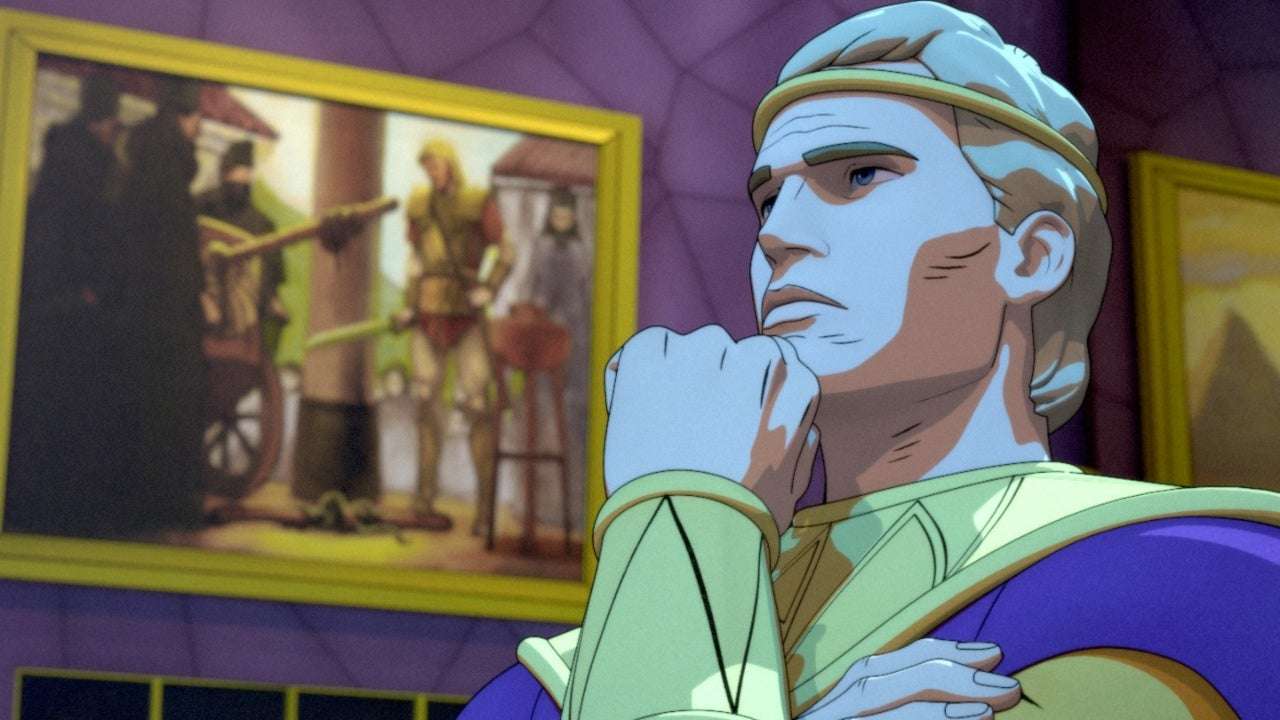
Rohrshach, the moral absolutist, absolutely couldn’t stand the compromise and decided to walk away from the Karnak and make a trip back. He had previously dropped his journal detailing his investigation in the mail. But his trek back to Archie would be interrupted by Manhattan. And Rohrshach’s determination bordering on obstinance faces against Manhattan’s cold logic, and Manhattan destroys Rohrshach into pieces, to the shock of Drieberg and Laurie.
Why does Dr. Manhattan leave Earth?
Manhattan’s final conversation with Veidt finds him least interested in validating Veidt’s feelings or acting as his absolution. He understands Veidt’s extreme pragmatism without condemning or condoning. He has chosen to leave Earth having lost interest in their affairs. Instead, he would leave this galaxy for a “less complicated one” and try to create new life, as his newfound interest in human life seems more scientific than emotional. He leaves Adrian with a sobering thought in reply to Adrian’s statement of everything having worked out in the end: “Nothing ever ends.”.
The film, unlike Manhattan’s statement, does end with Laurie and Dan visiting Sally Jupiter, having taken on alternate identities of Sandra and Sam Hollis, respectively. Laurie and her mother also reconcile, with Laurie revealing that she knows about her parentage and doesn’t blame her mother. In the world of “Watchmen,” at the very least these two get a happy ending. The dedicated reader of “Tales of the Black Freighter” finishes the story confused at its bleak tonality. The viewers and readers are left with a tantalizing thought of Rohrshach’s journal being discovered and printed by the New Frontiersman.
Watchmen: Chapter II (2024) Review:
Serving as a direct continuation to the first installment, essentially ensures one watches both these movies back to back to gain the full vision of director Brandon Vieti and screenwriter J. Michael Straczynski’s adaptation. Even after having seen this adaptation, it still feels at times rushed, especially in this installment with regards to the animation.
A majority of the faults and merits of this adaptation that had been voiced in my review of the first film remain mostly unchanged. The slavish adaptation of the source material is offset by the balancing act that Straczynski’s adept handling of the screenplay manages to execute. Like the first installment, here too the Tales of the Black Freighter is integrated exceedingly well, with the choice to cut to the events of that pirate comic back and forth with Ozymandias’ journey explored in this installment paying off in maintaining suspense.
Speaking of Ozymandias, Troy Baker’s voice work in unraveling the sly and terrifyingly determined nature of Ozymandias works well here. He is far less obvious in his evil-doings than Matthew Goode’s interpretation in Snyder’s adaptation or in Irons’ impish iteration in the 2019 television series that retroactively serves as the sequel to the comic as well as this adaptation. His subtlety belies his ambition and cruelty, and Baker brings it to life with a searing intensity.
Similarly, Katee Sackhoff’s voiceover work as Laurie Juspecyzk is brought to greater focus here, as we explore her vulnerability and confusion in navigating her emotional dilemma while dealing with Osterman as well as Drieberg. Titus Welliver, whose voice work as Rohrshach/Walter Kovacs had been the most divisive addition in this adaptation, feels far less jarring this time around. It’s almost as if Welliver is more comfortable with the character, or it could also be that he tried to bring forth an extra gravelly layer to the voice on account of the mask Rohrshach wears, which he is out of for the majority of this film.
Matthew Cerveris’ iteration of Doctor Manhattan, unfortunately, doesn’t work in this installment, which is a shame because Manhattan has some of the strongest epiphanies in this installment and some of the more poignant observations about the foibles of humanity that would have been impactful under the hands of a better performer.
The problem, unsurprisingly, is the animation, and this time it is noticeable. The criticism afforded to both films for using cel-shaded animation rather than utilizing Gibbons’ color and artwork in the original comic is a valid one. But at least in the first installment, the animation itself doesn’t feel rushed, quite like in this, especially in the linework and in the movements of the characters. The action set pieces, as a result, feel janky and strangely lifeless this time around and thus strangely distract from the events occurring in the film.
If anything could be credited to this adaptation, it is successfully animating the final, terrifying massacre of New York that had been orchestrated by Ozymandias. This two-part adaptation doesn’t exactly justify its existence. But, at least in terms of fidelity, it remains faithful almost throughout, with interstitial info added as extra scenes or as animatics in the opening and closing credits. Honestly, nothing could ever capture the potency of the graphic novel or the experience of voraciously reading through it. But considering that the film manages to stick to the landing, it at least stands among the pantheon of DC comics adaptations that could work as a gateway to the source material.




